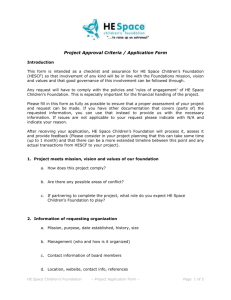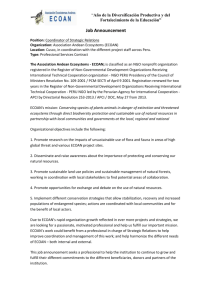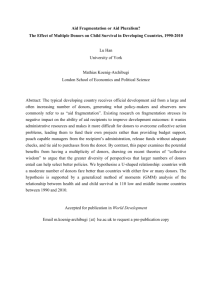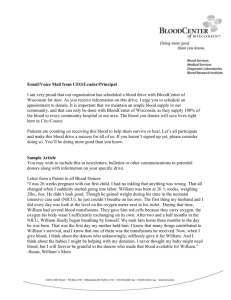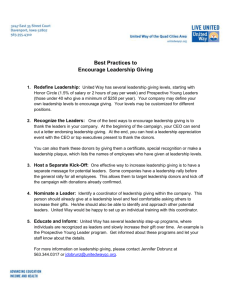Situational Assessment - Complementary Currency Resource Center
advertisement
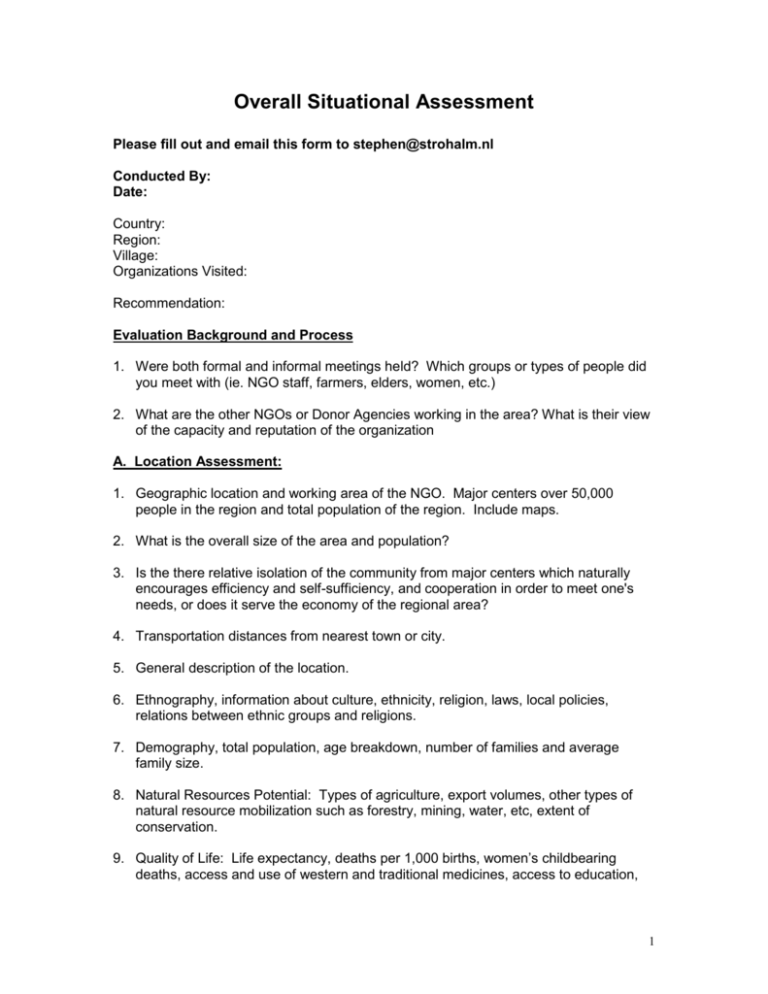
Overall Situational Assessment Please fill out and email this form to stephen@strohalm.nl Conducted By: Date: Country: Region: Village: Organizations Visited: Recommendation: Evaluation Background and Process 1. Were both formal and informal meetings held? Which groups or types of people did you meet with (ie. NGO staff, farmers, elders, women, etc.) 2. What are the other NGOs or Donor Agencies working in the area? What is their view of the capacity and reputation of the organization A. Location Assessment: 1. Geographic location and working area of the NGO. Major centers over 50,000 people in the region and total population of the region. Include maps. 2. What is the overall size of the area and population? 3. Is the there relative isolation of the community from major centers which naturally encourages efficiency and self-sufficiency, and cooperation in order to meet one's needs, or does it serve the economy of the regional area? 4. Transportation distances from nearest town or city. 5. General description of the location. 6. Ethnography, information about culture, ethnicity, religion, laws, local policies, relations between ethnic groups and religions. 7. Demography, total population, age breakdown, number of families and average family size. 8. Natural Resources Potential: Types of agriculture, export volumes, other types of natural resource mobilization such as forestry, mining, water, etc, extent of conservation. 9. Quality of Life: Life expectancy, deaths per 1,000 births, women’s childbearing deaths, access and use of western and traditional medicines, access to education, 1 information, literacy level, informal education systems, violence in general and against women, security and criminal activities, average income per year. 10. Gender Inclusiveness and Sensitivity. Do many women work in the office? What are their positions? Do women play an active role in the organization? 11. What is the general Social / Political / Economic Situation? Economic Conditions 12. Is there a relatively broad range of local enterprises, community assets in terms of buildings, utilities, education, skills, experiences (community mapping exercise will reveal this), reasonably developed home-based industry, existence of local marketplace or community hall? 13. Is there good coverage by local savings and credit institutions, with a corresponding high demand for credit & savings services? 14. Is there a variety of goods and services are offered to trade? 15. Is there the existence of unused local business capacity, due to a lack of local demand? Social Conditions 16. Is there a relatively stable, unified and integrated society with community leaders, relative freedom of thought and choice, low level of external fear factors (police/army intimidation, criminal gangs, etc.)? 17. Is there motivation on the part of community leaders and the community to improve the situation in their community, honesty, integrity, low-level of corruption? 18. Are leaders seen by the community as acting in the best interests of the community first and not using their positions for self-benefit? 19. Is there willingness on the part of the community, as well as the leaders, to take risks and to experiment with new ideas in any field, whether medicine/health, agriculture, industry, economics, etc 20. Do community leaders trust each other in terms of exercising their influence on the community, community leadership is unified in improving the lives of the members of the community? 21. Are community leaders willing to employ a participatory approach to implement its activities. For example, members participate in designing the regulations of the system, workplan and budget? Political Conditions 22. Do National, Regional and Local governments support the idea of using a second currency to support community development in the project area? 2 23. Are there significant legal or political obstacles to establishing a local means of exchange? Cultural Conditions 24. Do adults and elder members of society still recall how things were done 30 years ago or more and how these practices may differ from the present situation? 25. Is there a culture of mutual aid and reciprocity? Human Resources Conditions 26. Are there community members with skills in accounting, simple management, office skills, etc? 27. Do community organizations practice good management and transparency? Motivation Conditions 28. Are community programs regarded by community members as a tool to solve their problems? 29. Do community programs have the support of a spiritual leader within the community? Civil Society Conditions 30. Is there the existence of local Non-Governmental and Community-Based Organizations and successful local development projects preferably of an internal but also of an external nature? 31. Is there a culture of mutual aid and volunteerism in civil society terms? 32. Does the community have positive experiences in implementing various self-reliant initiatives? 33. Do the villagers ask for a new tool to deal with their current problems? B. Partner Assessment Name of Potential Partner Organization: 1. Incorporation: date and type of incorporation. 2. Organizational structure, board members 3. Projects | Type | Participants | Budget | Outcomes | Description 4. Funders | Who | How much | What for | Project status 5. Key Related Personnel: 3 Name | Position | How long in Position | Understanding of their Position 6. Successful Past Projects: Description | Impact | Budget | Funder 7. History of Organization Organizational Capacity: 1. Organizational management, vision/mission of the organization, history of establishment, programs and activities, about the founder of the organization, program budget allocations, Strategic plan of the organization, structure of the organization, activities conducted this year and next. 2. Program management: was the program designed with the input of the community? How is monitoring and evaluation processes conducted? How is the quality of the reports and publications? Which donors have supported the organization? 3. Financial management: is there a procedure for the management of finances? Has there been an audit of the finances? How is the quality of the financial reports? 4. Human Resources Management: how is the system of recruitment and mobility of staff? Are there programs for developing staff capacities? Are staff doing jobs for which they have the education/training/experience and capacity to do? 5. Information and Documentation Management. Does the organization maintain a database of their information? 6. Partnership: who is in the organization’s network? What are the benefits that have been received from the network? 7. Public Relations: Is the organization seen as credible and visible in the operations areas of the organization? C. Program Potential Assessment Some of these questions may appear out of order, they refer to our internal analysis of situation assessments. Please try to answer them. 1. Does a local financial institution exist (preferably cooperative savings group, credit union or member-owned bank) with the capacity to provide financial management to the program. Most preferred is a sufficiently large and well-managed microfinance institution that is willing to participate? 2. Is there a willingness to channel part its own funding through a local currency system? 3. Is the proposed project significant in monetary terms? 4. Is the timeline of the proposed project at least one year, preferably longer, in duration? 4 5. Does the project have a gradual expenditure pattern (so projects that last a year but spend 90% in 1 months are less suitable) 6. Does the project have a high local spending component? 7. Is the local government interested? This would be an important advantage as local governments can make an extra "loop" in the circulation because they accept local currency as tax and spend it back into the community. 8. Is there a certain degree of diversity in the local economy? The Bonus system is more difficult to introduce in a pure import/export economy. 9. Is there competition going on in the area between donors? If so, this could make it difficult to convince the donors to spend their funds through a Bonus, and if they did, they would be less attractive to other donors who pay 100% national currency. 10. Is there a sufficient level of social solidarity, cooperation and interaction? If not, perhaps may consider a Community Cooperation program first. 11. Is there sufficient diversity of the local economy? 12. Is the community location near to a significant-sized urban center with a population of over 50,000 people? 13. Is there a broad range of businesses and/or cooperatives? 14. Is there suitable electricity, telephone and internet capabilities? 15. Please attach a Logical Framework Analysis of your proposed program. Activities must have outputs, which must be measurable, which lead to outcomes that have impacts in order to achieve the overall goal. Overall Goal Impact Outcomes Indicators Outputs Activities 5
